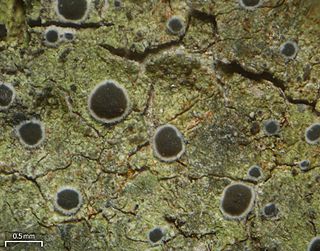
Ramalina is a genus of greenish fruticose lichens that grow in the form of flattened, strap-like branches. Members of the genus are commonly called strap lichens or cartilage lichens. Apothecia are lecanorine.

Byssoloma is a genus of leaf-dwelling lichens in the family Pilocarpaceae.
Septotrapelia is a genus of lichen-forming fungi in the family Pilocarpaceae. It has four species. It was validly published as a genus in 2007 by lichenologists André Aptroot and Jose-Luis Chaves.

Gassicurtia is a genus of lichenized fungi in the family Caliciaceae.

Enterographa is a genus of lichens in the family Roccellaceae.

Mazosia is a genus of lichen-forming fungi in the family Roccellaceae. The genus was circumscribed by Italian lichenologist Abramo Bartolommeo Massalongo in 1854.

Canoparmelia is a genus of lichen-forming fungi in the family Parmeliaceae. The widespread genus contains about 35 species. Canoparmelia, a segregate of the parmelioid lichen genus Pseudoparmelia, was circumscribed by John Elix and Mason Hale in 1986.

Parmotrema is a genus of lichen belonging to the family Parmeliaceae. It is a large genus, containing an estimated 300 species, with a centre of diversity in subtropical regions of South America and the Pacific Islands.

Relicina is a genus of foliose lichens belonging to the large family Parmeliaceae. It contains 59 species.

Pyrrhospora is a genus of lichen-forming fungi in the family Lecanoraceae. The genus was circumscribed by German lichenologist Gustav Wilhelm Körber in 1855, with Pyrrhospora quernea assigned as the type species.

Protoparmelia is a genus of lichenized fungi in the family Parmeliaceae. The genus has a widespread distribution, and contains 11 species. Protoparmelia was circumscribed by French lichenologist Maurice Choisy in 1929.
André Aptroot is a Dutch mycologist and lichenologist.

Loxospora is a genus of lichen-forming fungi in the family Sarrameanaceae. It has 13 species. The genus was circumscribed by Italian lichenologist Abramo Bartolommeo Massalongo in 1852, with Loxospora elatina assigned as the type species. This crustose lichen was originally named Lecanora elatina by Erik Acharius in 1810.

Halecania is a genus of fungi in the family Leprocaulaceae. It has 22 species. The genus was circumscribed by Austrian lichenologist Michaela Mayrhofer in 1987, with Halecania alpivaga assigned as the type species. She created Halecania to contain species, formerly placed in Lecania, with the following characteristics: uniformly amyloid apical domes, paraphyses with dark brown apical caps, and halonate ascospores.

Megalospora is a genus of lichen-forming fungi in the family Megalosporaceae.

Herpothallon is a genus of crustose lichens in the family Arthoniaceae. It has about 50 species.
Henricus (Harrie) Johannes Maria Sipman is a Dutch lichenologist. He specialises in tropical and subtropical lichens, and has authored or co-authored more than 250 scientific publications. He was the curator of the lichen herbarium at the Berlin Botanical Garden and Botanical Museum from 1983 until his retirement in 2010.
Celotheliaceae is a family of fungi in the monotypic order Phaeomoniellales. The family was proposed in 2008 by Robert Lücking, André Aptroot, and Harrie Sipman, while the order was circumscribed in 2015. It is sister to the clade that includes the orders Verrucariales and Chaetothyriales. Molecular clock calculations suggest that the order originated when gymnosperm diversification occurred.

Robert Lücking is a German lichenologist. He earned his master's and PhD from the University of Ulm, focusing on the taxonomy, ecology, and biodiversity of foliicolous lichens. He has received numerous awards for his work, including the Mason E. Hale award for his doctoral thesis, the Augustin Pyramus de Candolle prize for his monograph, and the Tuckerman Award twice for his publications in The Bryologist. Since 2015, he has been serving as the curator of lichens, fungi, and bryophytes at the Berlin Botanical Garden and Botanical Museum, and several lichen species and a genus have been named in his honour.
Megalotremis is a genus of lichen-forming fungi in the family Monoblastiaceae. It has 16 species. The genus was circumscribed by Dutch lichenologist André Aptroot in 1991, with Megalotremis verrucosa assigned as the type species. Megalotremis is a pyrenolichen genus, meaning its species have perithecioid ascocarps: spherical or flask-shaped, sessile or partly immersed in the thallus, with a single opening (ostiole) and enclosed by a distinct wall.














